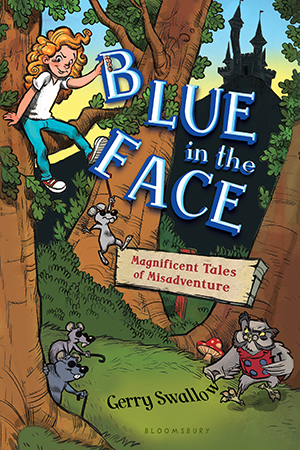| ________________
CM . . .
. Volume XXIII Number 32. . . April 28, 2017
excerpt:
Elspeth Pule is a terror. Her tantrums keep her mum and dad browbeaten and scared, and she’s been expelled from seven schools. If this 11 year old wants a llama, by gosh, she’ll find a way to get a llama, and it doesn’t matter whose golf clubs or cremation urn she smashes in the process. But on the day her parents decide to ignore her famous breath holding tactic, she passes out and wakes in another world. In this magical kingdom, Little Bo Peep, Humpty Dumpty and the Crooked Man are all real, but their personal histories don’t quite match the legends Elspeth has grown up with. Little Robin Redbreast is a gossip, Georgie Porgie is a yes man, and the three blind mice are only slightly visually impaired. Elspeth isn’t impressed though and can’t wait to get home, but this will involve finding a magical well which is guarded by the army of the evil king. It is soon clear the Elspeth is actually the daughter of Jack and Jill who have been in prison ever since they managed to send their baby daughter into “the Deadlands” for safety. She, it seems, is the heroine prophesied to restore deposed monarch Wee Willie Winkie to his throne. Blue in the Face features a revolving door of well known characters from nursery rhymes and fairy tales. Although some readers will love these over the top cameos, they can get a tiny bit tedious. The most wonderful characters in the story are the original creations, such as trusty sidekick Gene the stick. The other most memorable character is the Cheese (who otherwise stands alone), and, while he originates in a literary reference, the characterization and character arc is quite brilliant and inventive. Swallow never passes up an opportunity for a silly pun or joke. The plot is a classic fantasy adventure. Elspeth has a quest and an important destiny she is, at some times, unwilling to fulfill. She must travel the land, free her birth parents, lead an army against the dictator and finally find her way home. Along the way, she will find unlikely friends. She will also learn how to work with other people. As time passes, she begins to appreciate her own parents. She will embrace the stubborn side of her personality which allows her to be a good leader while understanding that screaming and yelling for what you want is a pain for everyone else. Elspeth’s character development is natural and believable. She remains a very spirited heroine but mellows a little and come to realize her own good fortune. The novel explores plenty of themes, some very much by design, and others by happenstance. Swallow includes unlaboured statements about inclusiveness. Because of the humourous content of the story, this message is embedded in the book in a natural way which will appeal to kids while also being a positive message. When Elspeth turns her back on the ragtag rebellion, she says, “They’re not my people. In fact, most of them aren’t even people at all. There’s a stock, a spoon, a goose, a slab of cheese, and one guy who’s half egg on his mother’s side.” But Farrah, who was once Elspeth’s doll and is now engaged to deposed King William, persuades her that all good people are worthy of help, regardless of what they look like. Of course, Elspeth does eventually succeed in dethroning Old King Krool. Like all fairy tales, Blue in the Face is a story about a conservative rebellion. The old king has been ousted and replaced by a tyrant. But the monarchy and its hierarchical structure are accepted as positive values. Solving the world’s problems is just a question of restoring a benevolent dictator rather than enduring life under an evil one. Fairy tales usually allow a lowly character to attain social status and to change the world for the better. But the larger power structure and social order is not questioned; rather it is reinforced. Since Blue in the Face is a reimagining and mash up of this genre, I hoped that it might offer some more progressive messages. Unfortunately the urge to innovate did not go that far. Blue in the Face also provides an opportunity to think about the nature of storytelling. Elspeth is surprised to find that the stories she has read are not always true. Some are propaganda; others have been distorted for different reasons or just lost something in translation. This allows readers to think about stories they know and how they could be retold with different meanings. It also shows how characters can be borrowed and shared, tying in to the history of fairy tales which have traditionally morphed over time. Blue in the Face is perhaps longer than it needs to be, but it always remains highly readable, rollicking along in a continuous series of jokes and adventures. The story will be enjoyed by many readers, but, despite its many nods to classic children’s books, it never quite achieves the depth or appeal of the tales that have stood the test of time. Recommended. Kris Rothstein is a children’s book agent and reviewer in Vancouver, BC.
To comment
on this title or this review, send mail to cm@umanitoba.ca.
Copyright © the Manitoba Library Association. Reproduction for personal
use is permitted only if this copyright notice is maintained. Any
other reproduction is prohibited without permission.
Next Review | Table of Contents For This Issue -April 28, 2017 |
